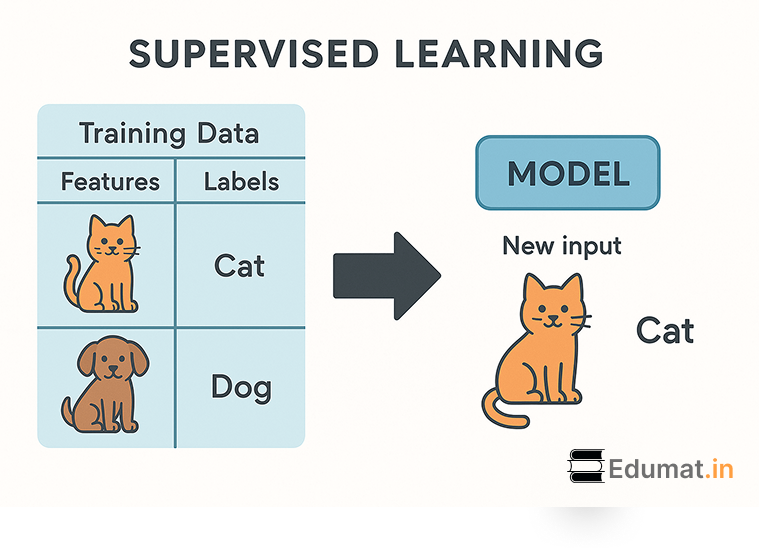A Gentle Introduction to Machine Learning (ML) — For Curious Minds Beyond the Basics
Technology • May 19, 2025

Mukesh Juadi

Machine Learning (ML) is no longer a buzzword reserved for tech giants or researchers. From personalized recommendations on Netflix to fraud detection in banking, ML is shaping our digital interactions daily. 🌐
But what really is Machine Learning? How does it work under the hood? And how can we break it down in an intuitive, visual, and structured way? Let’s dive in! 🚀
📘 What is Machine Learning?
Machine Learning is a subfield of Artificial Intelligence (AI) that focuses on designing systems that learn from data and improve over time without being explicitly programmed.
Formal Definition:
Machine Learning is a computer program’s ability to learn from experience (data), with respect to a class of tasks, and performance measure, without being explicitly programmed.
— Tom M. Mitchell, ML pioneer
🧭 Why Not Just Traditional Programming?
Here’s a quick comparison:
| Aspect | Traditional Programming | Machine Learning |
|---|---|---|
| Input | Data + Logic (Rules) | Data + Output |
| Output | Desired Output | Inferred Logic (Model) |
| Flexibility | Rigid — needs explicit rules | Adaptive — learns patterns from data |
Example: Email Spam Detection
- 🛠 Traditional way: Write rules like “If the subject contains ‘win money’, mark as spam.”
- 🤖 ML way: Train a model on thousands of labeled emails and let it learn the characteristics of spam on its own.
📊 Types of Machine Learning (with Visuals in Mind)
Let’s classify ML based on how data is provided during training.
1. Supervised Learning:
Think of a teacher guiding a student with correct answers.
You provide labeled data: both input (features) and output (labels).
Example:
| Email Text | Label |
|---|---|
| "You won $1,000!" | Spam |
| "Meeting at 3 PM" | Not Spam |
Used in: Image classification, email filtering, loan approval systems

2. Unsupervised Learning:
There are no labels. The model finds structure or patterns.
It tries to group or organize data based on similarities.
Example: Customer segmentation
Given user data:
| Age | Income | Spending Score |
|---|---|---|
| 23 | 30K | 65 |
| 45 | 80K | 20 |
| 21 | 32K | 60 |
ML might cluster them into:
- Group A: Young + high spending
- Group B: Older + moderate spending
Used in: Market segmentation, anomaly detection, topic modeling
3. Reinforcement Learning
Inspired by trial-and-error learning, like training a pet.
An agent learns to take actions in an environment to maximize reward.
Example: A self-driving car learns that obeying signals earns positive rewards; running a red light incurs a penalty.
Used in: Robotics, Game AI (e.g., AlphaGo), Traffic control systems

🧠 Core Concepts (Made Intuitive)
Let’s build an ML model like teaching a student math.
- Data (The Textbook): Quality and quantity matter. The model learns patterns from this.
- Features (Chapters to Study): The measurable pieces of input data. E.g., height, weight, price, color.
- Labels (Answer Key): The correct answers used in supervised learning. E.g., “Spam” or “Not Spam”.
- Model (The Student’s Brain): A mathematical function that maps inputs to outputs based on training.
- Training (Study Time): The process where the model adjusts itself based on data.
- Loss Function (Feedback/Grade): A measure of how wrong the model is. The goal: minimize this.
- Optimization (Improving the Student): Tweaks the model using techniques like
Gradient Descentto improve accuracy.
🏗️ A Realistic ML Workflow
Here’s a typical workflow for building an ML model:
Each step involves thoughtful design and experimentation. A good model is only as good as its data and tuning.
🎯 Creative Example: Predicting House Prices
Let’s imagine you’re building a model to estimate house prices.
Data (Sample):
| Area (sq ft) | Bedrooms | Location Quality | Price ($) |
|---|---|---|---|
| 1200 | 2 | 7 | 180,000 |
| 2000 | 4 | 9 | 320,000 |
| 850 | 1 | 6 | 100,000 |
You feed this data into a supervised learning algorithm (like Linear Regression) and it learns the relationship:
Price = (area × weight₁) + (bedrooms × weight₂) + (location × weight₃) + bias
After training, you input:
1500 sq ft, 3 bedrooms, 8 location score
→ Model predicts: $250,000
🧪 Common Algorithms (No Deep Math)
| Algorithm | Type | Best for |
|---|---|---|
Linear Regression |
Supervised | Predicting numbers |
Decision Tree |
Supervised | Classification |
K-Means Clustering |
Unsupervised | Grouping similar data |
Naive Bayes |
Supervised | Text classification |
Random Forest |
Supervised | General purpose, good accuracy |
Q-Learning |
Reinforcement | Decision making with rewards |
⚖️ Limitations and Challenges
- Bias in data can lead to unfair predictions
- Overfitting: Model memorizes instead of learning
- Data privacy: ML models need lots of sensitive data
- Interpretability: Many models are black boxes
📚 Learning Resources
| Resource | Type | Notes |
|---|---|---|
| Google’s ML Crash Course | Free course | Beginner-friendly with exercises |
| Coursera - Andrew Ng’s ML | MOOC | Classic, well-structured |
| Scikit-learn Documentation | Library Docs | Great for practicing algorithms |
| Google Colab | Cloud Notebook | Run Python ML code in browser |
🧭 Conclusion
Machine Learning is not magic — it’s a powerful and structured approach to learning patterns from data. With the right understanding of types, tools, and techniques, you can begin building real-world models for tasks ranging from spam detection to price forecasting.
Next step? Try building a simple ML model using a tool like scikit-learn on a dataset from Kaggle or UCI ML Repository. The best way to learn is by doing! 🌟
📚 Want to Learn More About Tech and ML?
Get smart notes, tutorials, and resources in slide & PPT format — all in one place.
👉 Boost your tech knowledge on Edumat.in – your tech learning hub!
🔖 Tags
Machine Learning introduction 2025 types of Machine Learning ML for beginners supervised learning unsupervised learning